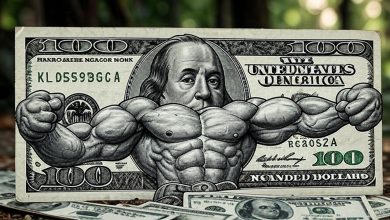How An ARM Can Save And Make You More Money On A Home

About once a month, I get an email or comment from a reader criticizing adjustable-rate mortgages (ARMs) as a poor financial choice. Since I’ve been a proponent of ARMs since starting Financial Samurai in 2009, I understand the pushback. Roughly 95% of homebuyers with mortgages get 30-year fixed-rate mortgages.
However, I still prefer an ARM over a 30-year fixed-rate mortgage because I don’t want to pay more in interest than necessary. Yes, there will be periods of higher interest rates, like the one we’re experiencing since 2022. And yes, your ARM may occasionally reset during a high inflation period. However, over the long run, I believe the broader interest rate trend is down, driven by technology, efficiency, and globalization.
An ARM allows you to pay less in mortgage interest, lower your monthly payments, borrow more, and better align your fixed-rate period with your expected homeownership tenure. If you are an experienced real estate investor, an ARM can be a great choice.
Here’s an example of ARM pushback:
Hey Sam,
I know you’ve been a supporter of ARMs for years. I get the logic as you’ve laid it out, but for my investment properties and my primary home, I refinanced in 2020 and 2021. All my rates are fixed between 2.6% and 3.5%. I’d argue that longer-term fixed 15- and 30-year mortgages worked better.
I know several people who had ARMs and either sold their investment properties or are still dealing with negative monthly cash flow. You may still believe in ARMs for yourself, but maybe it’s time to revisit the topic in light of today’s environment. Perhaps I’m missing their merits.
When mortgage rates surged in 2022 after years of aggressive fiscal stimulus, criticism of ARMs intensified. Suddenly, locking in a 30-year fixed mortgage at 2.5% – 2.75% at the bottom of the market looked like a stroke of genius — and it was.
But here’s the thing: Both an ARM and a 30-year fixed mortgage can be smart moves if used strategically. The right choice depends on your financial situation, risk tolerance, and homeownership goals.
Let me share a case study illustrating how an ARM saved me money and even helped me make more money.
I’ll also explain why ARMs could be ideal for lower-risk homebuyers who are personal finance enthusiasts. While 30-year fixed mortgages may be better suited for higher-risk buyers, which often describes the typical American homeowner.
Case Study On How Using An ARM Saved And Made Me Money On A Home
In April 2020, one month after COVID lockdowns, I stumbled across an amazing home with panoramic ocean views. This was somewhat of a problem since I had just purchased a home in April 2019.
My original plan was to gut remodel my 2019 fixer and expand it to about 2,840 square feet. Unfortunately, after one year of remodeling, I realized it wouldn’t get done by the end of 2020 due to COVID delays. So I decided to look for another home.
The new home I found in 2020 was fully remodeled and had over 2,800 square feet. As the father and primary income earner, my #1 responsibility was to provide for my family. Our daughter had just been born in December 2019, and I didn’t want her to have to live through construction.
In the end, I decided to get a 7/1 ARM at a 2.15% interest rate. I could have gotten a 30-year fixed-rate mortgage at a 2.5% interest rate, but I wanted to save money. In addition, getting an ARM enabled me to borrow more money to purchase the home since the payment was lower.
More importantly, deep down, I knew this new home was not my forever home. It was the same size as what my 2019 home would ultimately end up as. It just had slightly nicer views and finishes.
I foresaw my family and me living in the home for up to 10 years before moving to Honolulu.
Sold The Home Five Years Later For A Profit
My forecast for owning the home for up to 10 years didn’t play out. Instead, greed took over because I found an even nicer home in 2022. Luckily, I couldn’t afford it at the time. However, once the home came back on the market at a lower price in 2023, I could. My stocks had rebounded and I had saved more money.
After purchasing another home in 2023 and renting out my 2020 home, I finally sold it in 2025, saving myself ~$31,000 in mortgage interest expense by going with an ARM.
I also made a greater absolute and percentage return because I was able to borrow more with an ARM. An ARM boosts purchasing power because the initial payment is lower, which improves your debt-to-income (DTI) ratio in the eyes of the lender. The return boost was an additional ~5 percent, or about $25,000. Overall, the home appreciated by about 20%.
I don’t know about you, but saving and earning an extra $56,000 over five years by choosing an ARM is a big deal. That’s the equivalent of six hours flying private, 15,000 McDonald’s cheeseburgers, or a full year of Lean FIRE living! You might not be a great negotiator or market timer when buying a home—but you sure as heck can control your expenses and save smart.
Would Have Been Nice To Full Exhaust The ARM
It’s tough letting go of a 2.125% mortgage rate. Ideally, I would’ve held onto the 2020 home for seven years—right up until the last month before the rate reset. The property likely would’ve appreciated further, and I could’ve enjoyed my negative real interest rate mortgage for even longer.
Oh well. You can’t optimize everything. Even if the ARM reset higher, it would have only increased by 2% to 4.125% in year eight. Remember, ARMs have caps on how much they can adjust, so they’re not as risky as many think. Plus, you’re also steadily paying down principal during the fixed-rate period, which improves affordability over time.
Hence, the lesson from my ARM case study is to know thyself. Based on my obsession with real estate, my then desire to climb the property ladder, and my net worth growth forecasts, I anticipated wanting a new home around the time the 7/1 ARM introductory rate was set to expire. And sure enough, it did.
The second lesson from my ARM case study is to focus on what you can control. A key part of reaching financial independence sooner is increasing your savings rate. The harder part is figuring out how to invest that money wisely. Choosing an ARM to save on interest and better align with your homeownership duration is the easier part.
The Formula That Helped Me Decide On An ARM
As a personal finance enthusiast, you’re constantly running financial models to forecast the future. In my situation, I calculated what the 2020 home purchase price was relative to my net worth. Then modeled out what it would likely decline to over a three-, five-, and 10-year period.
Finally, I referred to my recommended primary residence as a percentage of net worth chart to decide how much home I could responsibly buy. Then I calculated at what point the 2020 home would start to feel like not enough (less than 10% of net worth).
I am a fan of optimizing my living arrangements, especially with family. Both my wife and I don’t have to go anywhere to work, so we highly value owning a nice home. But if we had to go to the office for 12 hours a day, perhaps not.

To help clarify my formula for deciding on an ARM, let’s create an example.
My recommendation for financial freedom seekers is to spend no more than 30% of your net worth on a home. Or, if you’ve already purchased a home, grow your net worth until your home is worth less than 30% of your net worth.
Formula Example For Using An ARM
Net worth: $3.5 million
Target home price: $1 million
The target home equals 28.5% of your net worth, which is within the ideal recommended percentage.
You forecast your net worth to grow by 10% a year for the next 10 years. As a result, your net worth grows to $4.66 million in three years, $5.36 million in five years, and $9.078 million in 10 years. As a side note, here’s how you might feel after reaching various millionaire milestones.
For simplicity’s sake, let’s say your house is worth $1.2 million after three years (from $1 million purchase) and stays there. Your house is now worth only 26%, 22%, and 13.2% of your net worth after three, five, and ten years, respectively.
Given you don’t want to live so frugally after 10 years, you happily take a 10/1 ARM at a 0.375% lower mortgage interest rate than a 30-year fixed to save. You know that there’s no point in making money if you don’t spend it. In 10 years, you will most likely want to buy a nicer house.
If you don’t buy a nicer house in 10 years, then there’s less of a need to work so hard today. But you’re a highly motivated professional who wants to climb the corporate ladder, make more money, and live the best life possible.
Therefore, getting a 30-year fixed-rate mortgage at a higher interest rate — fixed for 20 years longer than your likely holding period — is not ideal.
Getting a 30-Year Fixed Rate Is Fine, Don’t Worry
Just because I’d rather get an ARM doesn’t mean having a 30-year fixed-rate mortgage is bad. It’s not!
Feel great about your 30-year fixed-rate mortgage, especially if you refinanced or took one out near the bottom of the interest rate cycle. What a gift to be able to borrow money so cheaply. Then to be able to earn a higher risk-free rate in money markets or Treasuries is another blessing.
We all like to think the financial choices we make, especially large ones, are the best ones. All I ask is that you don’t make blanket statements that an ARM is bad. There are financial situations and life circumstances where getting an ARM to buy a home at a lower interest rate is a great solution.
Saving money and matching the fixed-rate duration to your homeownership period is a more optimal choice. However, paying a higher mortgage interest rate for greater peace of mind is also worth a lot to many people.
The interest rate spread was just too high to be worth it to me at the time in 2020. If I could have gotten a 30-year fixed-rate mortgage for only 0.125% – 0.25% more, I may have taken it.
30-Year Fixed For More Risky Homebuyers
If you’re cranking up the risk by spending much more than 30% of your net worth on a primary residence, then getting a 30-year fixed rate will provide more peace of mind.
The typical American has between 70%-80% of their net worth in their primary residence, which is way too much in my opinion. This high percentage of net worth is why so many homeowners got crushed during the 2008 Global Financial Crisis period.
Therefore, the typical American getting a 30-year fixed-rate mortgage is a way to protect themselves given their concentration risk. It also protects the rest of us who aren’t willing to take such risk. We don’t want our home values to get hammered due to foreclosures.
An ARM For Less Risky Homebuyers
If you’re not betting the farm and buying a primary residence equal to 30% of your net worth or less, taking more “risk” by getting an ARM may be more appropriate. You’ve crunched the numbers and feel good about the various financial scenarios in the future. Even if your ARM resets to the maximum interest rate, you’d still be fine because you have so much more net worth left over to cover it.
I hope you enjoyed this case study on how using an ARM can save you money, help you build wealth, and align with your homebuying goals. I’m sure some will disagree, and that’s fine. The most important thing is to run the numbers and choose the mortgage that best suits your unique situation.
Readers, why do you think so many people are against ARMs? Is it simply a fear of the unknown or a lack of firsthand experience? Wouldn’t it make more sense to lock in a lower rate during a fixed period that better aligns with your actual real estate holding timeline?
If you’re looking to invest in real estate passively, check out Fundrise—my preferred private real estate platform. Fundrise focuses on high-quality residential and industrial properties in the Sunbelt, where valuations are lower and yields are higher.
Some commercial real estate valuations have dropped to levels near the 2008 financial crisis lows, despite today’s stronger economy and healthier household balance sheets. Seeing this as an opportunity, I’m dollar-cost averaging into the sector with my home-sale proceeds while prices remain attractive. The minimum investment is only $10.

Fundrise is a long-time sponsor of Financial Samurai and I’ve invested $300,000+ with them so far. About half of my invest in Fundrise is in their venture capital product. I want to build a decent amount of exposure to private AI companies.
Join over 60,000 readers and sign up for my free weekly newsletter. Everything I write is based on firsthand experience. Founded in 2009, Financial Samurai is a leading independently-owned personal finance sites today. I am the author of the new USA TODAY bestseller, Millionaire Milestones: Simple Steps To Seven Figures.
Source: How An ARM Can Save And Make You More Money On A Home




